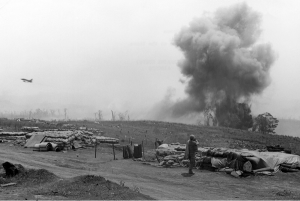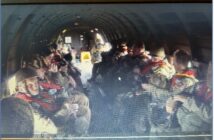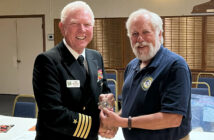The Grampaw Pettibone Squadron was honored to have Mr. Stephen Tucker, share his knowledge and experience serving as a US Marine Corps helicopter pilot at the battle of Khe Sanh, South Vietnam during the Tet Offensive of 1968. Cindy Macha, GPS Ops Officer introduced our speaker.
Mr. Tucker served on active duty as a US Marine from 1966-1970, becoming a Naval Aviator in September 1967. During his period of service, he spent February 1968-March 1969 as a Marine Helicopter pilot in South Vietnam.
Our speaker began his talk by first recognizing the sacrifice paid by over 58,300 US personnel who gave their lives during their service in Vietnam and the over 303,000 wounded both mentally and physically.
Further acknowledgment was extended to those in the audience who served and particularly those who were at Khe Sanh in 1968. He thanked the US Marines for making him a man and the US Navy for making him a pilot.
 Our speaker’s first duty station was at LTA/Marine Corps Air Station Tustin. His advanced training was in the Sikorsky H-34 helicopter. A 7000 pound payload with easy access to load and unload. After completing 90 hours of training, our speaker received orders for Vietnam.
Our speaker’s first duty station was at LTA/Marine Corps Air Station Tustin. His advanced training was in the Sikorsky H-34 helicopter. A 7000 pound payload with easy access to load and unload. After completing 90 hours of training, our speaker received orders for Vietnam.
Upon arriving in Vietnam, Stephen was assigned to HMM-364 and initially flew as co-pilot in the Boeing Vertol CH-46 helicopter. His first base was Phu Bai. The aircraft had a 7000 pound payload but was larger and faster than the H-34 previously assigned.
Outlining the timeline of the events surrounding the 1968 Tet (Lunar New Year Celebration) Offensive, began with a stated ceasefire from 27 Jan – 3 Feb. North Vietnam violated the truce on 30 Jan by infiltrating NVA personnel to join up with the Viet Cong in the south of the country. Major cities and strategic locations were attacked, lists of personnel supporting the South Vietnamese government and US military were created and thousands were tortured and killed. Mass graves were created by the attackers. US forces and the South Vietnamese government and military were caught off guard. Almost 6000 in the city of Hue were murdered. The job of the South Vietnamese and US Military was to identify and eliminate the enemy and return control to the South.
The attack during this period by the NVA and Viet Cong included the shelling and rocketing of military bases to destroy air assets. While the destruction did impact operations, the large inventory of available replacements reinstated needed equipment in short order. The response to the equipment reinstatement led the enemy to attacking the personnel and buildings where pilots and crews were housed. The actions of the North Vietnamese Army and Viet Cong was a coordinated large scale offensive that encompassed the entire country.
Khe Sanh was a US Marine Corps outpost south of the Vietnamese Demilitarized Zone and came under siege beginning on 20 January. Some 40,000 enemy surrounded the base defended by approximately 6000 Marines. The movement of supplies and reinforcements by ground transportation was curtailed. Massive shelling and mortar attack beginning 21 January and lasting 2 days resulted in the death of 18 Marines and injury to an additional 40. Between 30-31 January over 100 cities in South Vietnam were under attack. By the end of city battles, 37,000 V.C. were killed and many more wounded and captured. Reports of 68,000 NVA killed countrywide.
 Photos were shown indicating the severity of the attack and daily shelling that the base personnel experienced. Additional photos identified the complexity of the NVA tunnel and trenching network surrounding the base.
Photos were shown indicating the severity of the attack and daily shelling that the base personnel experienced. Additional photos identified the complexity of the NVA tunnel and trenching network surrounding the base.
Attempts to resupply the base initially called for aircraft to land, offload supplies and take out wounded. This resulted in a number of aircraft being destroyed on the ground during resupply missions. Eventually resupply was carried out by low level fly-by and the release of material and equipment by secure pallet or parachute. One tactic to recover wounded or re-supply by helicopter required displaying false signals to confuse enemy artillery or mortar fire. Once an initial false landing was presented, it required 30 seconds for the pilot to land, off-load, load and depart at the actual landing zone before enemy fire could be redirected.
 One method of resupply was a procedure called the “Super Gaggle”. This was a combined effort with marking mortar fire, close air-jet support and up to 7 helicopters delivering supplies. Gunners would fire smoke on known enemy anti-aircraft sites and the jets would target the sites. This would be followed by very fast supply flights to deliver material and recover wounded. Additional delivery of napalm and bombs against enemy ground movement prevented base perimeter wire penetration and enabled supply aircraft to deliver materials with minimal damage.
One method of resupply was a procedure called the “Super Gaggle”. This was a combined effort with marking mortar fire, close air-jet support and up to 7 helicopters delivering supplies. Gunners would fire smoke on known enemy anti-aircraft sites and the jets would target the sites. This would be followed by very fast supply flights to deliver material and recover wounded. Additional delivery of napalm and bombs against enemy ground movement prevented base perimeter wire penetration and enabled supply aircraft to deliver materials with minimal damage.
Steve noted that the “Super Gaggle” saved between 150-200 casualties and perhaps 6 or more aircraft and crew. During the month of February, helicopters flew over 15,700 sorties in 5,300 hours to deliver 3,100 tons of cargo and over 14,500 personnel for the hills. As weather improved so did the performance.
Our speaker noted his unit, HMM-364 flew 422 actual instrument hours and 246 radar departures/approaches, all with max loads. “It was a constant battle to fight vertigo and not lose control of the A/C….the beauty of 2 pilots @ the controls! “ A total of 45 days in IFR weather.
An average day during the siege saw: 350 tactical-fighter bombers, 60 B-52s, 30 light observation/recon a/c and 60-80 helicopters, all within the airspace surrounding the hills and base at Khe Sanh. Our speaker’s unit HMM-364 delivered material and men for 101 days at Khe Sanh before resuming operations at their new assignment.
Our speaker noted a comment by Leonard F. Chapman, General U.S.M.C: “When a Marine in Vietnam is Wounded, Surrounded, Hungry, Low on Ammunition, or Water, he Looks to the Sky. He Knows, the Choppers are Coming.”
Completing his tour in Vietnam, Steve was reassigned to Pensacola at the Naval Education and Air Training Command, where he became an instructor pilot and served 18 months in that assignment until he completed his military service in 1970 as a Captain.




